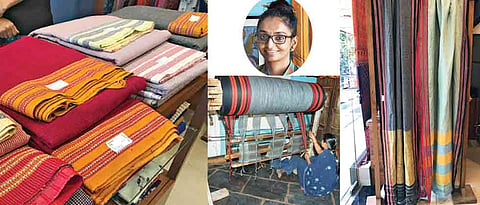

Thanks to #100 Saree Pact and other social media trends popularising it, many women now look forward to draping sarees. Handloom sarees are favoured, popular types like Banarasi, Tussar, Jamdani, Baluchari, Chanderi, are experimenting and are open to offering twists to appeal to the cool quotient of young women. And, yet a lot more needs to be done, specially when it comes to reviving weaves and patterns that have gone into oblivion. Gomi teni weave is one of them.
Hemalatha Jain, designer, textile revivalist and founder of Punarjeevana, is empowering weavers of North Karanataka through the revival of Patteda anchu sarees, and now Gomi teni. At a recently held exhibition at India Imprints on Prabhat Road in the city, Jain showcased some of the selected pieces from the weave. Jain, who is also teaching textile at Symbiosis International University in Pune, says, “I wondered why sarees have ceased to be a part of a woman’s wardrobe. Why are they not a part of their daily wear? This led to the revival project. Through my research, I realised that comfort and maintenance were the biggest issues. Hence I came up with a saree concept which doesn’t involve maintenance. It also has two different pallus, which can be reversed and worn. You don’t need to iron or starch it. Just wash and wear and you are good to go! These are ready-to-wear pieces, just like a pair of denims.”
You can pair the sarees, both Patteda anchu and Gomi teni, which have checks pattern, with tops, t-shirts, shirts, blouses etc and wear them on denims, jeggings or skirts. Since they are a little coarse in texture, they are easier to style. To make them more inclusive, Jain also has dupattas and stoles in different colour combination.
Patteda anchu and Gomi teni saree were woven in and around the villages of Gajendragarh, Belgaum, Raichur, Kodal, Bedar, Bellary, Gulbarga and Dharwad in Karnataka. “Gomi teni is named after its pattern of border and checks. It is short in width (43”) and 6 yards in length and was specifically designed for women working in farms. This coarse 20 count saree is made in cotton. The saree has specific colour palette that includes shades like yellow, red, pink and green.
Traditionally, they do not use black colour in the saree and hence it’s offered to goddess Yellamma Saundatti, the local deity of Gajendragarh village. However, we created sarees with a combination of black to give them a contemporary look,” she adds.
When asked, what differentiates a Gomi teni from a Patteda anchu, Jain replies, ‘Border’. “Gomi teni has a plain border, whereas the Patteda has detailing on its borders. These sarees go back to 10th and 12th century when the farmers wore very simple sarees. This weave was lost because of industrialisation, popularity of powerlooms and more and more sarees being available at cheaper price,” she replies.
“Gomi teni, like Patteda anchu, symbolises prosperity, was gifted to daughters, and daughters-in-law when they got married, when they conceived or on festivals. The border has the motif of jowar (sorghum) stalks, closely resembling the herringbone pattern,” adds Jain.
She went hunting for the saree and came across a freedom fighter who suggested that she can find the saree near a temple. “I met a the granddaughter of a devdasi, who was also a devdasi. I managed to get a sample from her and when tested, we found that it was 250 year old. I met another 60-year-old Lingayat woman who had received a Gomi teni saree from her grandmother,” says Jain, who is playing around with colour scheme and creating unique wefts to make each saree look different.
“We have six colours in Gomi teni with borders made with 20 and 40 counts, making them coarser than the body,” she adds.
Her previous weave Patteda anchu was copied by many on social media. “It is easier to sell online, but it also poses a threat of plagiarism. Too much of representation and copying is happening online. However, to tackle replication, we are changing the wefts and pallu styles so that it is not possible to create the same piece on powerloom,” Jain quips.
Since the designer was working with the master weaver who was well aware about the weaving of the traditional saree on pit loom, it was easy to set up one and convince him to make four colour options and border styles with 25 sarees on each loom.
“Their existing colour palettes for cotton yarn were golden yellow, red and chocolate brown. Local dyers were not ready to dye the new colours for cotton yarns. I had to train people with the new colours procured from Mumbai,” says Jain.
After dyeing followed by winding, creeling and warping process, the warp yarns go for sizing (starching) which strengthens and stiffens the yarns. “The pre-weaving processes for pit loom takes around four days and the loom is set for weaving the sarees. In a pit loom, the following process is repeated after six sarees are made.
To weave six sarees, it takes approximately three-four days. Since the process is tedious, weaving 100 sarees takes around 12 weeks,” she concludes.
